Chapter contents
I. Introduction
This chapter discusses the clinical features of HS and how to distinguish HS from other conditions that may look like it.
II. Clinical Presentation
HS can be diagnosed based on your physical exam (Table 2.1) and your symptoms. No skin biopsy or lab test is needed for diagnosis.
Three hallmark features of HS include typical lesions, typical distribution of lesions, and chronicity/recurrence (Table 2.2).
HS usually presents after puberty; however, children can also have HS (see Chapter 9 for more information on pediatric HS). The disease can start with occasional painful skin bumps and later involve abscesses, tunnels under the skin, and scars. The classic areas where HS lesions most commonly appear are in skin folds, such as the armpits and groin. Compared to women, men are more likely to also be affected by HS around the anus and buttock areas, as well as in non-classic areas such as the ears and legs. Women tend to be most affected on the frontal areas of the body, such as the breasts and groin.
Table 2.1. Types of HS lesions
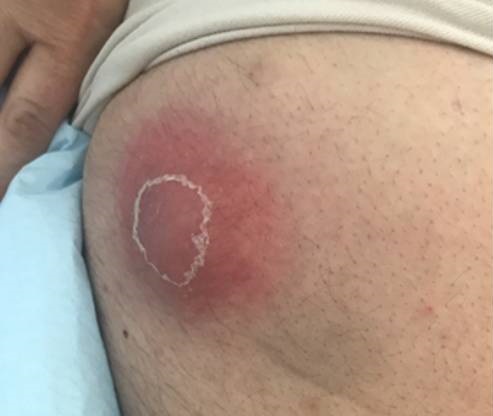
Abscess or boil. A tender, swollen lesion
that is usually filled with pus
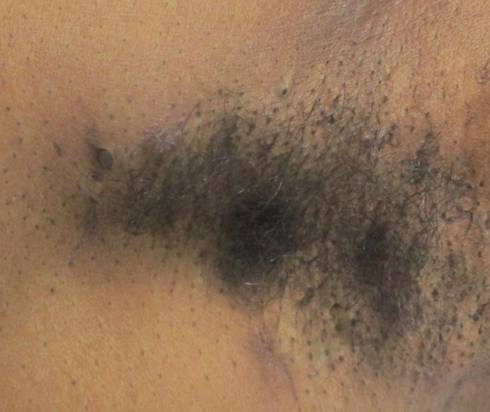
Comedone. Blackhead
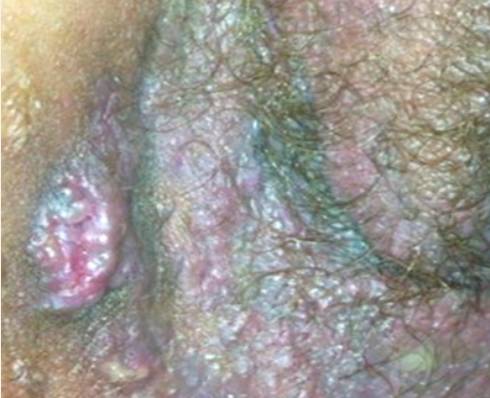
Nodule. A solid, spherical bump that is
>1 cm and may be tender (inflamed)
or non-tender (not inflamed)
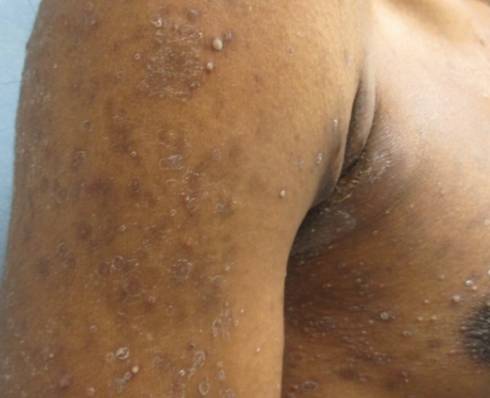
Pustule. A pus-filled bump

Scar. Irreversible tissue damage
due to inflammatory HS lesions that
can be flat, raised, or rope-like
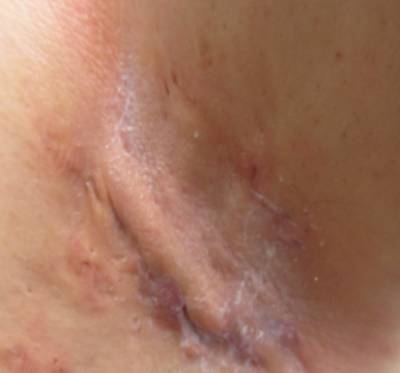
Sinus tract. A linear tunnel that may
open onto the skin surface

Ulcer. Open sore or break in the skin
| Characteristic of HS | Description |
|---|---|
| Typical lesions | Blackheads, abscesses, nodules, tunnels, scars |
| Typical distribution of lesions | Skin folds, such as armpits, groin, buttocks, under the breast folds* |
| Chronic and recurrent disease | At least two flares within a six-month period |
III. Subtypes of HS
Different clinical subtypes of HS have been proposed. The characteristics of the “classic” HS subtype are: affected armpits and groin, female, and high BMI. Having “non-classic” disease or severe acne are features associated with severe HS.
The “follicular subtype” of HS is characterized by skin lesions such as the pilonidal sinus (a small tunnel at the top of the buttocks), comedones (blackheads), and severe acne. This subtype is more common in males, smokers, and those with a positive family history of HS. Other common characteristics of the “follicular subtype” of HS are increased disease severity and earlier disease onset.
Another subtype of HS, the “gluteal subtype,” is characterized by involvement of the buttocks and is commonly associated with less severe disease and lower BMIs. More research is being done to more accurately describe different subtypes of HS because this information may be helpful in guiding treatment decisions.
IV. Physical Findings and Investigations
HS is a systemic disease associated with several comorbidities like metabolic syndrome and depression, so screening should be done based on HS screening guidelines and clinical clues.
Typical screening may involve blood pressure assessment, hemoglobin A1C (which measures average blood sugar level over the past three months), and cholesterol level measurements. In certain cases, a referral to a gastroenterologist may be needed to evaluate for inflammatory bowel disease. A referral to a psychiatrist or psychologist to address depression, anxiety, or other mental health conditions may be needed.
Hormonal assessments may also be performed if there is evidence of a hormone imbalance. For example, if a female patient has irregular periods. Patients with HS may suffer from arthritis and back pain; therefore, a referral to rheumatology may be required. Referrals for smoking cessation, nutrition counseling, and sexual health counseling may be needed in individualized cases. More information on HS associated conditions and screening may be found in Chapter 6.
Importantly, skin biopsy, lab tests, and bacterial cultures are not needed to make the diagnosis of HS. If labs are checked, you may be found to have a low red blood cell count or high levels of inflammatory markers. You should discuss any lab abnormalities with your healthcare provider.
V. Physical and Emotional Symptoms
You may experience many different symptoms with your HS. Physical symptoms may include pain, itch, odor, drainage, and swelling. Emotional symptoms may include anxiety, sadness, and anger. These symptoms can have a significant impact on your quality of life (for more information, please see Chapter 5).
VI. Conditions that Resemble HS
Early HS lesions can mimic other disorders (Table 2.3). However, the chronicity and progression of HS, as well as the typical involvement of skin fold areas, can help distinguish HS from other conditions. If your healthcare provider is worried that your lesion is a furuncle (a skin infection), a bacterial culture can be performed to help with diagnosis, in addition to clinical information.
Another condition that can look like HS are the skin findings that can be seen in Crohn’s disease (CD). If you have perianal tunnels and are also experiencing gastrointestinal symptoms such as abdominal pain or diarrhea, you should talk to your healthcare provider to make sure you do not have CD. In addition, if you have ulcerative lesions and an anal fistula (an abnormal connection from the skin to the anus) that involves the anal sphincter, these are findings that tend to be suggestive of CD.
VII. Questions and Answers
Question 1 How is HS different from acne? AnswerAlthough HS and acne both affect hair follicles, they are typically found in different locations on the body. Acne typically affects the face, chest, and back, while HS typically affects the armpits and groin area. Several risk factors associated with HS are not associated with acne, such as smoking and obesity.
Question 2 How is HS different from just having an abscess? AnswerHS is not caused by an infection. An isolated abscess that is not occurring in the context of HS is typically caused by a bacterial infection. Sometimes, for example, cultures can help distinguish HS from an infectious abscess caused by a Staph infection. Unlike an infected abscess, HS is the result of an uncontrolled immune response of the skin surrounding hair follicles. In addition, HS predominantly occurs in skin folds, whereas an isolated abscess can be found anywhere on the body.
Question 3 What are signs that my HS disease is quiet? AnswerHS is a disease that has periods of activity and inactivity. When lesions have minimal to no pain, itch, or drainage, and there are no new lesions forming, then the disease is in a “quiet” state. HS tunnels and cord-like scars can be removed with surgery when flares are under control.
| HS Mimicker | How it differs from HS | Clinical Photo |
|---|---|---|
| Acne | Acne is usually located on the face, upper chest, and back and does not present with tunnels. | 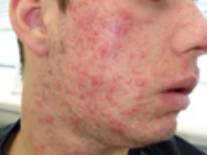 |
| Bartholin’s cyst | Presents with one-sided vulvar swelling and pain, tends to be solitary and to occur near the opening of the vagina | 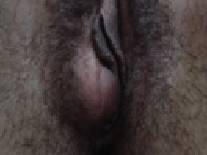 |
| Cutaneous Crohn’s disease | Cutaneous Crohn’s can also present with peri-anal fistula, but will not have comedones. Pelvic imaging can be helpful. |  |
| Epidermal inclusion cyst | Non-inflamed lesion, typically with a small dark-colored opening (a “punctum”) in the center of the lesion | 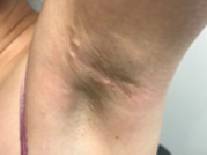 |
| Folliculitis | Bacterial or fungal infection of hair follicles that presents as scattered or isolated pus-filled bumps. The bumps usually heal without scars. | 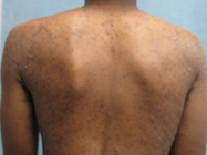 |
| Furuncle or Carbuncle | A furuncle is a deep and tender nodule caused by staphylococcal infection. Both the follicle and surrounding tissue are involved. A carbuncle is a group of connected furuncles. The lesions are contagious, could be associated with fever, and are not as recurrent as HS lesions. | 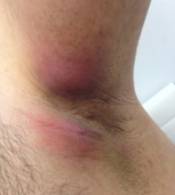 |
| Pyoderma gangrenosum | Ulcerative painful lesion with active purple border, often in sites of trauma | 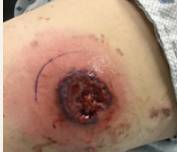 |